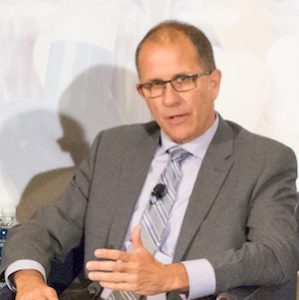Canadian Law Enforcement Veteran Urges Cross-Border Cooperation to Fight Fentanyl and Other Counterfeit Medicines

Don Bell spoke at PSM's 2018 Interchange in June.
This editorial by Don Bell was published in the Havre Daily News on August 21, 2018. Bell is a 33-year law enforcement veteran and the former chief superintendent of the Ontario Provincial Police.
U.S.-Canadian Partnership Vital in Addressing Illegal Fentanyl Crisis
Lost amidst the flurry of tariff-related disputes between the United States and Canada is an under-addressed and far weightier issue than steel. It is a lethal, but largely preventable threat: the trade and illegal importation of counterfeit drugs, most notably those containing fentanyl.
Trade between the U.S. and Canada exceeds $650 billion each year, but beyond this legal trade looms the danger of illicitly traded goods. Criminals take advantage of our soft border, which strong trade has created. Some illicit goods like weapons flow north, but many illicit goods flow south to the United States. For example, transshipments from foreign countries through Canada and then into the U.S. present an expanding avenue for illegal, dangerous, and counterfeit drugs. China, Hong Kong, and India are three principal export points of goods that are brought into the U.S. through Canada.
In my experience with the Canada Border Services Agency and the Ontario Provincial Police, the scope of the problem and the needs for tackling it are apparent. Clear communication and strategic cooperation are needed for the U.S. and Canada to comprehensively address the challenges that exist.
Some of the packages that are transshipped through Canada into the U.S. include illegal counterfeit drugs that are manufactured in hazardous conditions in countries far away by criminals without the authority, experience, or means to produce safe and effective products. These criminal entities sell the drugs online and attempt to pass them off as the “real deal.”
Worse yet, some of these drugs are laced with fentanyl, which is significantly more potent and deadly than heroin or morphine. The reach of fentanyl in illegal supply chains is extensive and indiscriminate.
Criminals like using Canada as moniker to pretend that the fake wares they peddle are safe. They disguise rogue foreign websites as Canadian pharmacies. In some cases, criminals even repackage the drugs in parcels with Canadian postage to fool Americans into believing that they have ordered what they perceive to be safe Canadian products. Across the Internet, outside the secure and regulated pharmaceutical supply chain, the Canadian brand can widely be perceived by consumers as desirable because of the cheap prices. However, as in the well-documented case of CanadaDrugs.com, criminals were shipping drugs with no active ingredients to unsuspecting cancer patients. U.S. policymakers are frequently considering proposals, like legalized importation, that would exacerbate this problem.
It’s critical that both countries continue to prioritize this devastating and deadly issue. First and foremost, the deterrents need to be stronger. Fentanyl’s high potency allows it to be shipped in small quantities making it difficult for inspectors to detect; moreover, the high profits gained from the illegal sale entices criminals to transport the contraband in small parcels accepting that only a small percentage will be seized. With a flood of fentanyl overwhelming the inspection system, the deadly consequences of this product entering our communities is far reaching.
Furthermore, increased resources are required, particularly when it comes to personnel and inspection capabilities. Large numbers of drug seizures are not analyzed in a timely fashion and the backlog can last for over a month, leading to stagnant enforcement.
One emerging issue is the prevalence of illegal pill presses, the tool for manufacturing deadly counterfeits. Despite legal controls, many of these tools have found their way into both the US and Canada that we’ve developed our own domestically-made counterfeit problem alongside the imported one.
Creating awareness plays a significant role in addressing this public safety crisis. From a law enforcement perspective, we cannot arrest ourselves out of this situation. The more that individuals understand the harm of counterfeit drugs and the risks involved, the sooner the issue can be addressed.
From my involvement in investigating organized crime, it is clear that the problem is far too big for any agency, level of government, or even country to handle on its own. What is truly needed is the enhancement of strong interagency partnerships between U.S. and Canadian authorities. In Canada, the term of art is mobilization throughout the federal, provincial, territorial, and municipality levels. This concept should be replicated by U.S. counterparts.
Mechanisms for sharing intelligence must also be further strengthened between our respective countries. Individual agents may only be focused on inbound effects to Canadian or U.S. citizens, respectively, but the reach of counterfeit drugs through transshipment points goes well beyond this. Those involved in organizations positioned to respond and get ahead of the counterfeit drug threat should seek to both augment existing relationships and foster new ones. This means working with international partners, including Chinese officials, to identify vendors at supply countries.
We should not allow trade wars and tariffs to distract from shared U.S. and Canadian interests in protecting citizens on both sides of the border. Ultimately, we must work together to comprehensively address the far-reaching consequences of fentanyl and other counterfeit medicines before they claim more lives.